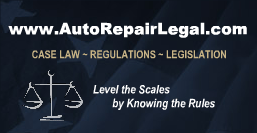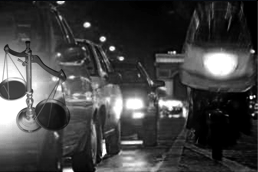

|
||||||||||||
|
|
|
|
|
|
Negligent Repairs Covered in Auto Policy Under Comprehensive Insurance -9/5/1984
09/05/84 Charles Caccioppo, v. United Services Automobile
[Editor's note: footnotes (if any) trail the opinion]
[1] CIVIL COURT OF THE CITY OF NEW YORK, QUEENS COUNTY
[2] Charles Caccioppo, Plaintiff,
v.
[3] United Services Automobile Association et al., Defendants
[4] 479 N.Y.S.2d 688, 125 Misc. 2d 698
[5] September 5, 1984
BLUE BOOK CITATION FORM: 1984.NY.
[6] APPELLATE PANEL:
[7] Joseph Rosenzweig, J.
[8] DECISION OF THE COURT DELIVERED BY THE HONORABLE JUDGE
ROSENZWEIG
[9] Plaintiff's cause of action against his insurance carrier is
based upon a loss to his automobile through the alleged negligence and
malfeasance of defendant C & S Diesel, Inc., an automobile repair shop.
[10] Dr. Charles Caccioppo in his complaint seeks to recover damages
in the amount of $4,500 from defendant United Services Automobile
Association under the terms of an insurance contract. Dr. Charles
Caccioppo in his second cause of action seeks to recover $4,500 from
defendant C & S Diesel based upon its negligence in the repair of Dr.
Caccioppo's automobile.
[11] Plaintiff moves for entry of summary judgment against the
defendant USAA on grounds that the amount of damages are the only
triable issue of fact. Plaintiff contends that the loss sustained to his
automobile which resulted from the alleged negligence of a mechanic is
covered under the provisions of part D of his insurance policy issued by
USAA.
[12] Defendant cross-moves for summary judgment dismissing the
plaintiff's complaint pursuant to CPLR 3212 (subd [e]).
[13] The first issue presented in this motion is whether the
insurance policy issued to the plaintiff covers an automobile mechanic's
negligence with respect to the comprehensive clause of the policy.
[14] The second issue is, assuming plaintiff is deemed to be covered
under comprehensive coverage for the damage to his automobile, whether
an exclusion provision is applicable.
[15] The third issue presented for analysis is whether there are
material facts in dispute which justify a denial of cross motions for
summary judgment. Under CPLR 3212 (subd [b]), if this court finds a
genuinely controverted fact on which liability depends then this court
is precluded from granting the motion.
[16] It is well settled that where insurance policies are concerned,
if the provisions are clear and unambiguous, then these provisions are
to be construed liberally in favor of the insured and strictly against
the insurer. (Government Employees Ins. Co. v Kligler, 42 N.Y.2d 863.)
[17] The insurance policy issued by the defendant in this case
clearly contains a provision regarding coverage for damage to a covered
automobile.
[18] Part D of the policy provides:
[19] "Coverage For Damage To Your Aut
[20] "We will pay for direct and accidental loss to your covered
automobile, including its equipment; minus any applicable deductable
shown in the declarations. However, we will pay for loss caused by
collision only if the Declarations indicate that collision coverage is
provided."
[21] The primary issue presented concerning this clause of the policy
is whether the alleged negligence of the auto mechanic to the
plaintiff's car was a direct and accidental loss to the covered
automobile within the meaning and terms of the policy indorsement.
[22] The reasonable interpretation of the phrase "direct loss" is
that it is synonymous with the phrase "direct cause" which in turn is
the legal equivalent of the words "proximate cause". (Dubuque Fire &
Mar. Ins. Co. v Caylor, 249 F2d 162.) Proximate cause has been defined
as the cause which in the natural and continuous sequence, unbroken by
an efficient intervening cause, produces the injury, and without which
the injury would not have occurred. (Lorang v Alaska S.S. Co., 2 F2d
300.)
[23] In Dubuque Fire & Mar. Ins. Co. v Caylor (supra), the United
States Court of Appeals for the 10th Circuit held that where antifreeze
solution containing ethylene glycol was inadvertently combined with the
crankcase oil already in the engine, it caused the pistons and
connecting rods to become overheated and the engines to seize and lock.
The court recognized that the damage to the engines constituted a direct
loss or damage from any "external cause" within the meaning of the
policy.
[24] In the case at bar, the policy provision states that the insured
is covered for direct and accidental loss to his covered automobile. The
declarations page of the insurance policy provides that plaintiff pay a
six-month premium of $115 for loss occasioned by other than collision
and a six-month premium of $233 for collision loss.
[25] This court finds that the language used in part D of the
insurance policy constitutes a comprehensive coverage clause which is
designed to afford protection against all causes of loss, damage or
destruction not specifically excluded. Based upon the declarations page
and the insurance agreement, this court finds that the comprehensive
clause which provided coverage "for direct and accidental loss to [the]
covered" vehicle affords protection to the insured for the alleged
negligence committed by the defendant C & S Diesel, Inc.
[26] The question then arises whether or not the exclusion denying
coverage for damage from mechanical failure or breakdown would apply to
any damage resulting by reason of an intervening cause such as the
negligence of a mechanic.
[27] Under the exclusion provision of part D, the insurance agreement
states: "We will not pay for . . . (2) Damage due and confined t (a)
wear and tear . . . (b) mechanical or electrical breakdown or failure."
[28] Defendant USAA contends that just as collision coverage applied
regardless of negligence, the mechanical breakdown exclusion would also
apply regardless of negligence.
[29] However, plaintiff argues that the alleged negligence of the
auto mechanic in performing repairs on plaintiff's car takes the alleged
damage outside the mechanical or electrical breakdown exclusion.
Plaintiff further contends that since the affidavit of defendant USAA
fails to state that the automobile suffered from a mechanical or
electrical breakdown prior to it being brought to the defendant C & S
Diesel, the exclusion in part D of the insurance agreement is not
applicable.
[30] After examination of both parties' contentions, this court finds
that if the alleged negligence caused a mechanical or electrical
breakdown of the automobile, then plaintiff will succeed in arguing that
the exclusion is not applicable by reason of an intervening cause.
[31] In Lunn v Indiana Lumbermens Mut. Ins. Co. (184 Tenn 584), the
court examined the meaning of the expression "confined to" as used in
the exclusionary provision of an automobile insurance policy. The court
held that the clause which excluded from comprehensive coverage any
damage to the automobile due and confined to mechanical or electrical
breakdown or failure does not restrict the operation of the clause to
the actual part of the automobile which breaks, and is to be interpreted
as meaning that the exclusion will not apply to damage done to any part
of the car by an intervening cause. However, the exclusion will apply to
any damage done to any part of the automobile solely by reason of the
mechanical breakdown.
[32] Under Lunn (supra), the insurance contract excludes the insurer
from liability for any damage caused solely by a mechanical defect. The
court's rationale for this holding was that the expression "confined
to", followed by "any damage to the auto" established that the exclusion
was limited to damage to the auto caused solely by a mechanical defect.
In order to determine whether the insurer is liable for the damage sued
for, it is necessary to determine whether the mechanical failure was the
sole proximate cause of the accident and the consequent damage. If it
was the sole proximate cause, then the insurer is not liable. If it was
not the sole proximate cause, then the insurance company is liable under
the comprehensive clause.
[33] Upon examining the affidavits, the court finds that the
plaintiff took his automobile to the mechanic for purposes of a tune-up.
However, the affidavits never indicate that the automobile suffered from
damage due to a mechanical or electrical breakdown or failure prior to
the alleged negligence.
[34] Although the exclusion in part D of the policy attempts to avoid
liability by the insurer for any damage to the automobile caused solely
by mechanical defects, the insurer remains liable for any damage brought
by an intervening cause.
[35] Prior to this court applying the exclusion provision to the case
at bar, there must be a trial as to whether or not defendant C & S
Diesel was negligent in performing repair work on plaintiff's car. If,
after trial, defendant C & S Diesel is found to have acted negligently
with respect to plaintiff's car, then the insurance company is liable
under the comprehensive clause on the basis that the auto mechanic's
negligence is an intervening cause. If defendant C & S Diesel is
determined not to have acted negligently, then the insurer is not liable
by reason of the exclusionary clause.
[36] Under CPLR 3212 (subd [b]), a motion for summary judgment shall
be denied if any party shall show facts sufficient to require a trial of
any issue of fact other than an issue as to the amount or the extent of
the damages.
[37] Summary judgment is a drastic remedy and should not be granted
where there is any doubt as to the existence of a triable issue.
(Moskowitz v Garlock, 23 A.D.2d 943.) The very question of whether the
defendant's conduct amounts to negligence is inherently a question for
the fact trier in all but the most egregious instances. (See Siegel,
Practice Commentaries, McKinney's Cons Laws of NY, Book 7B, CPLR
C3212:8, p 429.) In this case, that question can only be determined on
trial.
[38] HOLDING
[39] Plaintiff may be able to recover under an insurance policy where
damage is caused by the alleged negligence of an auto mechanic. The
negligent conduct of an auto mechanic causing damage to an automobile
can constitute a direct and accidental loss to a vehicle.
[40] The exclusion which avoids coverage for damage due and confined
to mechanical or electrical breakdown or failure will only apply where
the damage is caused solely by mechanical defects.
[41] This court must deny plaintiff's motion for summary judgment
since the affidavits raise a question of fact with regard to whether
defendant C & S Diesel was negligent. The trial court must determine
whether the auto mechanic acted negligently in the repair of plaintiff's
automobile before deciding whether the exclusion provision is applicable
to the case at bar.
[42] In order to determine whether the insurer is liable for the
damage sued for in this case, it is necessary to determine whether the
defendant C & S Diesel acted negligently and if such negligence was the
sole proximate cause of the accident. If defendant C & S Diesel were not
negligent, then the insurer is not liable under the comprehensive
clause. If the mechanic was negligent and such negligence was the sole
proximate cause of the mechanical breakdown, then the exclusion will not
apply, and the insurer will be liable under the comprehensive clause.
[43] Accordingly, the motion and cross motion for summary judgment
are denied.
[44] CASE RESOLUTION
[45] Accordingly, the motion and cross motion for summary judgment
are denied.
